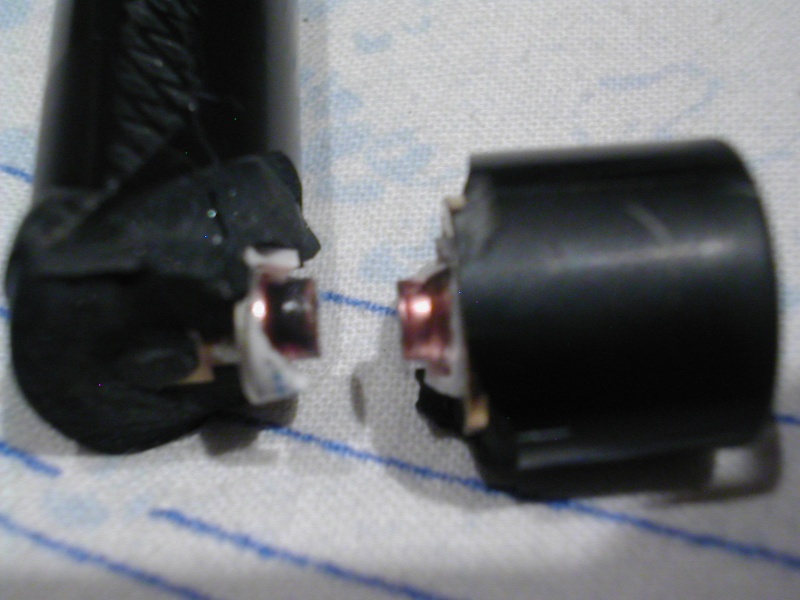1

 Spark Plugs and ignition wires Fri Oct 02, 2009 6:36 pm
Spark Plugs and ignition wires Fri Oct 02, 2009 6:36 pm
Crazy Frog
admin

I have read on other forums people finding after market ignition wires and caps.
This could be a big money saver, but..... (yes there is always a but)
The K100 is originally fitted with Bosch X5DC (or NGK D7EA) which is a non resistor spark plug. Here is the reason:
The spark plug cap already integrates a resistance of 5KΩ. Similarly, the connector at the other end of the ignition cable also includes a resistance of 1KΩ. The total resistance is 6KΩ
If you replace the wire with an after market non resistor wire and cap and keep the original spark plugs, you will run into troubles and take a chance to blowup the output transistors of the ignition module(You won't have any resistance at all).
It is possible to fit a K100 with after market plugs and wires, but the spark plugs have to be replaced with a resistive type (Bosch XR5DC). The XR5DC have a built in 5kΩ resistor.
What the number in the model # means?
The X(R)5DC has a thermal index of 5 the NGK D7EA has a thermal index of 7 but both are suited to be installed on a K100 engine....
Confusing? Well each manufacturer uses its own designation for the heat range:
Well each manufacturer uses its own designation for the heat range:
On the Bosch plugs the higher the number (from 4 to 8 ) the hotter is the plug. NGK works on the opposite and goes form 8 to 4 (a lower number indicates a hotter plug)
The term spark plug heat range refers to the speed with which the plug can transfer heat from the combustion chamber to the engine head. It has been found the optimum combustion chamber temperature for gasoline engines is between 500°C–850°C. When it is within that range it is cool enough to avoid pre-ignition and plug tip overheating (which can cause engine damage), while still hot enough to burn off combustion deposits which cause fouling.
The spark plug can help maintain the optimum combustion chamber temperature. The primary method used to do this is by altering the internal length of the core nose, in addition, the alloy compositions in the electrodes can be changed. This means you may not be able to visually tell a difference between heat ranges. When a spark plug is referred to as a “cold plug”, it is one that transfers heat rapidly from the firing tip into the engine head, which keeps the firing tip cooler. A “hot plug” has a much slower rate of heat transfer, which keeps the firing tip hotter.
Hope this information will be beneficial to you.
Bert
This could be a big money saver, but..... (yes there is always a but)
The K100 is originally fitted with Bosch X5DC (or NGK D7EA) which is a non resistor spark plug. Here is the reason:
The spark plug cap already integrates a resistance of 5KΩ. Similarly, the connector at the other end of the ignition cable also includes a resistance of 1KΩ. The total resistance is 6KΩ
If you replace the wire with an after market non resistor wire and cap and keep the original spark plugs, you will run into troubles and take a chance to blowup the output transistors of the ignition module(You won't have any resistance at all).
It is possible to fit a K100 with after market plugs and wires, but the spark plugs have to be replaced with a resistive type (Bosch XR5DC). The XR5DC have a built in 5kΩ resistor.
What the number in the model # means?
The X(R)5DC has a thermal index of 5 the NGK D7EA has a thermal index of 7 but both are suited to be installed on a K100 engine....
Confusing?
On the Bosch plugs the higher the number (from 4 to 8 ) the hotter is the plug. NGK works on the opposite and goes form 8 to 4 (a lower number indicates a hotter plug)
The term spark plug heat range refers to the speed with which the plug can transfer heat from the combustion chamber to the engine head. It has been found the optimum combustion chamber temperature for gasoline engines is between 500°C–850°C. When it is within that range it is cool enough to avoid pre-ignition and plug tip overheating (which can cause engine damage), while still hot enough to burn off combustion deposits which cause fouling.
The spark plug can help maintain the optimum combustion chamber temperature. The primary method used to do this is by altering the internal length of the core nose, in addition, the alloy compositions in the electrodes can be changed. This means you may not be able to visually tell a difference between heat ranges. When a spark plug is referred to as a “cold plug”, it is one that transfers heat rapidly from the firing tip into the engine head, which keeps the firing tip cooler. A “hot plug” has a much slower rate of heat transfer, which keeps the firing tip hotter.
Hope this information will be beneficial to you.
Bert
__________________________________________________
  1986 k75, 1985 K100rt, 1986 k75, 1985 K100rt, |
















